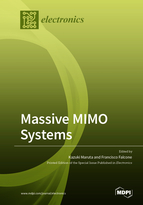Massive MIMO Systems
A special issue of Electronics (ISSN 2079-9292). This special issue belongs to the section "Microwave and Wireless Communications".
Deadline for manuscript submissions: closed (31 July 2019) | Viewed by 81719
Special Issue Editors
Interests: adaptive array; massive MIMO; cooperative base station; multihop relay
2. School of Engineering and Science, Tecnologico de Monterrey, Monterrey 64849, Mexico
Interests: wireless networks; performance evaluation; distributed systems; context-aware environments; IoT; next-generation wireless systems
Special Issues, Collections and Topics in MDPI journals
Special Issue Information
Dear Colleagues,
We are going to see the first decade since the fundamental concept of Massive MIMO (or called large-scale MIMO) has emerged. Massive MIMO technologies are now in implementation and trial stages towards 5G and beyond. Thanks to its excessive degree of freedom (DoF), massive MIMO has unlimited potentiality to further enhance system capabilities and still expands various research topics with depth. It can be further discussed and believed to break limitations in wireless communications such as spectral and energy efficiencies for better support of continuously increasing mobile data traffic, as well as terminals.
This Special Issue accordingly calls recent advances related to massive MIMO technologies that cover all signal processing, system level analysis, and implementation aspects. Topics of interest in this Special Issue include, but are not limited to, the following:
- Hybrid beamforming
- Beam tracking for moving target
- Millimeter wave
- Full digital-signal processing
- Energy efficiency and wireless power transfer
- Localization and direction-of-arrival (DoA) estimation
- Compressed sensing
- Pilot decontamination and channel estimation
- Antenna array configuration
- Machine learning approach for pre/post coding
- Implementation and caribration
- Proof-of-concept (PoC) and trials
Dr. Kazuki Maruta
Prof. Francisco Falcone
Guest Editors
Manuscript Submission Information
Manuscripts should be submitted online at www.mdpi.com by registering and logging in to this website. Once you are registered, click here to go to the submission form. Manuscripts can be submitted until the deadline. All submissions that pass pre-check are peer-reviewed. Accepted papers will be published continuously in the journal (as soon as accepted) and will be listed together on the special issue website. Research articles, review articles as well as short communications are invited. For planned papers, a title and short abstract (about 100 words) can be sent to the Editorial Office for announcement on this website.
Submitted manuscripts should not have been published previously, nor be under consideration for publication elsewhere (except conference proceedings papers). All manuscripts are thoroughly refereed through a single-blind peer-review process. A guide for authors and other relevant information for submission of manuscripts is available on the Instructions for Authors page. Electronics is an international peer-reviewed open access semimonthly journal published by MDPI.
Please visit the Instructions for Authors page before submitting a manuscript. The Article Processing Charge (APC) for publication in this open access journal is 2400 CHF (Swiss Francs). Submitted papers should be well formatted and use good English. Authors may use MDPI's English editing service prior to publication or during author revisions.







